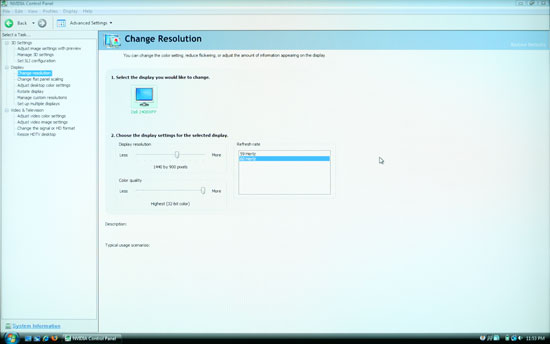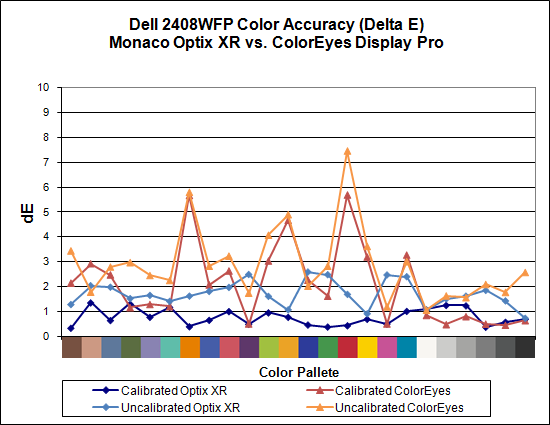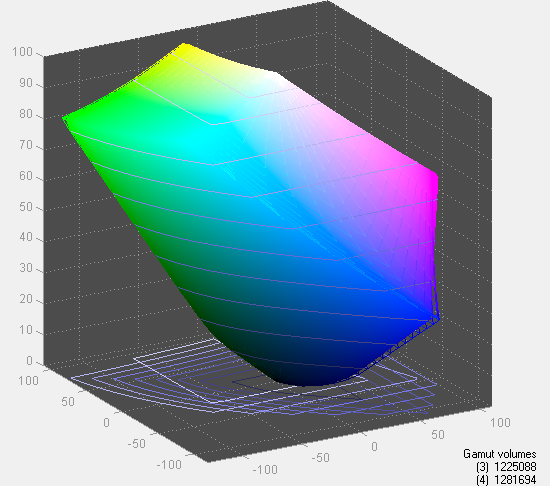Dell 2408WFP Evaluation
Looking at the OSD, the 2408WFP again follows in the footsteps of the 2407WFP. It comes with seven color presets, which can be further modified by selecting "graphics" or "video". PC and Mac gamma settings are also available. Picture-in-picture (PIP) is also available, provided one of the inputs is an analog connection.
You can see the various options available in the menu system in the above gallery. In terms of OSD buttons, we prefer Dell's approach to any of the other LCDs we've tested. Some people like "cloaked" touch-sensitive buttons, but we feel they tend to be less precise. Noteworthy items include DDC/CI support that can be used with calibration software and the options for aspect ratio control. This happens to be the first LCD we've tested that we were able to calibrate using DDC mode in ColorEyes Display Pro -- not that the results were significantly better, but it was nice to be able to input target values and have the software do the "dirty work" for us. About the only option that's missing is the ability to move the OSD away from center. (It can interfere with color calibration if you activate it with a colorimeter at the center of the LCD.)
For aspect ratio control, Dell provides three options: 1:1, Aspect, and Fill. Similar to the ASUS MK241H, "Fill" stretches whatever resolution you're running to fill the whole screen and "1:1" is a direct-mapped mode without any stretching, leaving black bars on all sides (depending on what resolution you're running). "Aspect" is a proportional stretch mode that maintains the resolution aspect ratio, so for example 1024x768 ends up filling 1600x1200 pixels (as do all other 4:3 aspect ratio resolutions) and 1280x1024 ends up filling 1500x1200. Here's a summary of our resolution testing:
| Dell 2408WFP Resolution and Input Notes | ||||
| Component | DVI | HDMI | VGA | |
| 800x600 | Yes | Yes | Yes | |
| 1024x768 | Yes | Yes | Yes | |
| 1152x864 | Yes | Yes | Yes | |
| 1176x664 | Underscanned 720P | - | Underscanned 720P | - |
| 1280x720 | Overscans (no way to disable) | Yes | Yes | Yes |
| 1280x768 | - | Wrong AR (1280x1024); Use "Full" scaling | Yes | |
| 1280x800 | Wrong AR (1280x1024); Use "Full" scaling | Wrong AR (1280x1024); Use "Full" scaling | Yes | |
| 1280x960 | - | Wrong AR (1280x1024) | Yes | |
| 1280x1024 | Yes | Yes | Yes | |
| 1400x1050 | - | Wrong AR (1920x1080) | - | |
| 1440x900 | Wrong AR (1600x1200); Use "Full" scaling | Wrong AR (1920x1080); Use "Full" scaling | Yes | |
| 1600x1200 | Yes | Yes | Yes | |
| 1680x1050 | Always fills LCD ("Full") | Wrong AR (1920x1080); Use "Full" scaling | Yes | |
| 1768x992 | Underscanned 1080i | - | Underscanned 1080P | - |
| 1920x1080 | Overscans (no way to disable) | Yes | Yes | Yes |
| 1920x1200 | - | Yes | Yes | Yes |
Most of the tested resolutions more or less work properly on any of the three main computer inputs. VGA mode performs flawlessly, while on DVI and HDMI inputs some of the widescreen resolutions require you to manually select "Fill". If you want a 1:1 image, a few resolutions have problems on DVI and most of the lower widescreen resolutions fail to work in this mode. As with all LCDs, there's an "auto adjust" function that executes when you change resolutions while using an analog input (i.e. VGA). This function works as expected and takes a couple seconds to execute; it apparently remembers the last 10 resolutions you've used; otherwise, the auto adjustment runs again.
Component input is rather disappointing, as 720P and 1080I both have ~10% overscan; using a PC, you can output 1176x664 or 1768x992 to avoid this, but if you're using a computer you will probably want to use one of the other input options. Even then you still end up with a black bar on the right. The 30Hz HDMI modes all overscan as well (1280x720, 1400x1040, 1440x900, 1680x1050, and 1920x1080) and show scaling/de-interlacing artifacts; in other words, don't use them if you can avoid it. Overall, 1080I seems better than 720P on the component video connection, so if you plan to connect the LCD up to a component video source, we would run 1080I.
 |
As you can see in the above image, scaling artifacts from over resolutions are not a serious problem. Running at the native resolution is definitely preferred, but if you happen to run a game at a lower resolution you should be fine. Connecting a gaming console to any of the inputs should also work well, but keep in mind the aspect ratio comments from above.


Taking a quick look at color accuracy and gamut, the overall color accuracy is exceptional. If you look at the above results, you might not believe that we were able to achieve a Delta E of only 1.7 without calibration! Yes, that's right: without hardware calibration, the Dell 2408WFP can surpass many other LCDs with hardware calibration. Just to be clear, we set the brightness and contrast to 50, selected the custom color profile, and dropped the RGB settings to 80; otherwise, the default settings tend to be quite bright. After calibration, scores further improve to an extremely low 0.78 average. The highest Delta E after calibration is only 1.31. Color gamut is also exceptional, and this is the only display we've tested so far that achieves better than 100% of the Adobe RGB 1998 standard.
Simply put the colors and color accuracy of the Dell 2408WFP absolutely blew us away. If you're an imaging professional and you're using Windows (we have heard there can be some issues with high gamut LCDs under Mac OS X, particularly with the Safari web browser), this is the best LCD we've tested so far. Perhaps more surprising is the fact that you can pick it up for only $600 (at least with the current sale -- MSRP is usually $700). Top that off with a 3-year manufacturer warranty and you've got a delicious LCD soup ready to serve up. The only fly in the ointment is the aforementioned input lag, which could present problems if your primary computer applications or games and your reflexes are so honed that you can notice the ~30ms lag. If that's the case, you'll probably need to compromise on image quality and pick up a TN panel LCD.
















89 Comments
View All Comments
Rasterman - Friday, May 9, 2008 - link
Yeah the figures reported are meaningless, if they were actually useful we wouldn't even need reviews :) I can't believe that a company as big as Viewsonic doesn't send a review site as big as Anandtech a review model, that is just ridiculous, they should be sending you guys a new model of every new monitor without even asking, maybe you aren't emailing the right person. BTW its awesome to see a reviewer actually answer questions and critics to a review, awesome job Jarred!JarredWalton - Friday, May 9, 2008 - link
I'm sure I'm not getting the right person at Viewsonic (and other companies as well), but that's the trick: *finding* the right person. Without an inside contact, it can be tough to get started.Generic PR Person: "AnandTech? What kind of a name is that? http://www.homestarrunner.com/sbemail50.html">Baleeted!" I'll try to meet with them next CES or something....
PS - Anyone from Viewsonic read this? If so, email me! :-)
10e - Tuesday, May 6, 2008 - link
Great review. This is what multifunction fans are looking for. I had this issue a year ago trying to find "THE" multifunction.You may want to mention that in terms of 720p and 1080p the Samsung stretches both to 16:10 with A/V mode off. I tested this and found that problem recently, which was unfortunate due to the fact that I liked it as a high quality TN.
JarredWalton - Tuesday, May 6, 2008 - link
I mentioned this on page 11, but I have highlighted (italicized) the pertinent text. I also clarified by indicating that 16:9 modes will always have the wrong AR. Thanks for reading and commenting!xerces8 - Monday, May 5, 2008 - link
A picture says more than 1000 words :http://www.digitalversus.com/duels.php?ty=6&ma...">http://www.digitalversus.com/duels.php?...2=49&...
(I can't create a link, seems the post javascript is broken, I cant make bold or italics text either, tried FF and IE7)
JarredWalton - Monday, May 5, 2008 - link
You mean, http://www.digitalversus.com/duels.php?ty=6&ma...">pictures like this one? I don't see any large blowups of their comparisons available for download, so I have no idea exactly how they're testing. What I do know is that I provided images showing LaCie 324 and Dell 2408WFP clearly displaying a 40ms delay relative to an HP LP3065, and I've also provided a picture of the ASUS MK241H with a relative delay of 0ms relative to the same LCD.I've got nine other sample images from each of the tested monitors showing the evidence for my "input lag" conclusions. That's about as close to full disclosure as you'll get. All I get on that comparison you linked is a chart that apparently "proves" the ASUS MK241H has a 54ms average delay compared to a CRT, but then the same site lists the Dell 2408WFP as 69ms, the 2407WFP as 24ms, the LaCie as 41ms, and the Samsung 245T at 59ms. I got more or less the same result on the Dell 2407WFP and the LaCie 324, but nowhere near the same result on the MK241H, 2408WFP, and the 2493HM.
Again, you've got at least one clear sample of my results for each LCD. Sorry, but I have to question their results without better evidence.
Dashel - Monday, May 5, 2008 - link
Hi Jarred,Not sure if this is based on the same test or what but there is this:
http://www.behardware.com/art/imprimer/712/">http://www.behardware.com/art/imprimer/712/
Which looks to be the same graph and results. To me your results seem to make the most sense if the 2408 is very similar to the 2407WFP-HC, then the input lag should be close too I would guess. I'm hardly an expert just tryint to be logical.
The thing is I also see anecdotal claims of lag and people who have tested it getting in the 60ms range as well which leads me to wonder if there isnt some sort of defect or difference in some of the panels vrs others.
Example of a test by an owner:
http://www.hardforum.com/showpost.php?p=1032124531...">http://www.hardforum.com/showpost.php?p=1032124531...
I'd love to hear Dells thoughts on it as well as what and when their revision is due to hit.
JarredWalton - Monday, May 5, 2008 - link
I'd like to know what software people are using as timers. I tried about 10 different "timers" and discovered that a bunch are limited to the Windows default timing resolution - about 54ms. So they either scored "0ms" or "54ms" on the delay. I know this because I had screen refreshes where the timer was split in half; the top half would show for example 40.067 and the bottom would show 50.121.3DMark03 at least looks to be accurate down to 10ms - there are again pictures where the timer is cut in half, only in such cases I would see 20.23 and 20.24, so I can be sure that the timer is updated in .01s increments rather than in something larger.
Without a lot more details about what software people use and large images showing the results, I must say that I'm very skeptical. I feel "input lag" testing needs several things to be even remotely acceptable:
1) Run at native LCD resolution in clone mode (because built-in scalers could have an impact)
2) Disclosure of the test software that manages better than 54ms accuracy.
3) You need a high-end camera with a fast shutter speed to capture the results. Simply choosing "Auto" mode and snapping a picture doesn't tell the whole story.
4) Provide at least one sample image at a high resolution that clearly shows what the camera captured.
I met all of those criteria I think. In looking around at other reviews, I have not been able to clearly answer any of those questions. Perhaps that's why some of the other results are so different. I also tested at 2560x1600 to verify that I wasn't hurting the HP LP3065 by running at a lower resolution; since the scaling is handled by the GPU rather than the LCD (the LP3065 doesn't have a scaler), there was no penalty.
DangerousQ - Monday, May 5, 2008 - link
I cant believe this set of reviews is so one sided, why no P-MVA panels, I bought a BenQ FP241W about 3 monyths ago and the 6ms response time plus unbelievable colours make this panel really hard to beat, but you try finding any reviews on it. The one review I did find, a long time ago and have lost it now compared it to the 2407 dell and found it a better panel for less money! I know this cos I was going to buy the dell before I saw the review.JarredWalton - Monday, May 5, 2008 - link
Send me an MVA panel - or get one of the manufacturers to send me one - and I will be more than happy to review it. I don't have the means to go out and purchase $500+ test LCDs, so I review what I get sent. Dell, Gateway, Samsung, ASUS, and other major companies are great about working with review sites like ours. Other companies are not. Thus, I take what I can get.